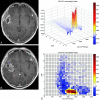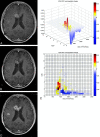Differentiation of tumor progression from pseudoprogression in patients with posttreatment glioblastoma using multiparametric histogram analysis
- PMID: 24676005
- PMCID: PMC7966603
- DOI: 10.3174/ajnr.A3876
Differentiation of tumor progression from pseudoprogression in patients with posttreatment glioblastoma using multiparametric histogram analysis
Abstract
Background and purpose: The multiparametric imaging can show us different aspects of tumor behavior and may help differentiation of tumor recurrence from treatment related change. Our aim was to differentiate tumor progression from pseudoprogression in patients with glioblastoma by using multiparametric histogram analysis of 2 consecutive MR imaging studies with relative cerebral blood volume and ADC values.
Materials and methods: Thirty-five consecutive patients with glioblastoma with new or increased size of enhancing lesions after concomitant chemoradiation therapy following surgical resection were included. Combined histograms were made by using the relative cerebral blood volume and ADC values of enhancing areas for initial and follow-up MR imaging, and subtracted histograms were also prepared. The histogram parameters between groups were compared. The diagnostic accuracy of tumor progression based on the histogram parameters of initial and follow-up MR imaging and subtracted histograms was compared and correlated with overall survival.
Results: Twenty-four pseudoprogressions and 11 tumor progressions were determined. Diagnosis based on the subtracted histogram mode with a multiparametric approach was more accurate than the diagnosis based on the uniparametric approach (area under the receiver operating characteristic curve of 0.877 versus 0.801), with 81.8% sensitivity and 100% specificity. A high mode of relative cerebral blood volume on the subtracted histogram by using a multiparametric approach (relative cerebral blood volume ×ADC) was the best predictor of true tumor progression (P < .001) and worse survival (P = .003).
Conclusions: Multiparametric histogram analysis of posttreatment glioblastoma was useful to predict true tumor progression and worse survival.
© 2014 by American Journal of Neuroradiology.
Figures






Similar articles
-
True progression versus pseudoprogression in the treatment of glioblastomas: a comparison study of normalized cerebral blood volume and apparent diffusion coefficient by histogram analysis.Korean J Radiol. 2013 Jul-Aug;14(4):662-72. doi: 10.3348/kjr.2013.14.4.662. Epub 2013 Jul 17. Korean J Radiol. 2013. PMID: 23901325 Free PMC article.
-
Prediction of pseudoprogression in patients with glioblastomas using the initial and final area under the curves ratio derived from dynamic contrast-enhanced T1-weighted perfusion MR imaging.AJNR Am J Neuroradiol. 2013 Dec;34(12):2278-86. doi: 10.3174/ajnr.A3634. Epub 2013 Jul 4. AJNR Am J Neuroradiol. 2013. PMID: 23828115 Free PMC article.
-
Differentiation of true progression from pseudoprogression in glioblastoma treated with radiation therapy and concomitant temozolomide: comparison study of standard and high-b-value diffusion-weighted imaging.Radiology. 2013 Dec;269(3):831-40. doi: 10.1148/radiol.13122024. Epub 2013 Oct 28. Radiology. 2013. PMID: 23771912
-
Imaging Glioblastoma Posttreatment: Progression, Pseudoprogression, Pseudoresponse, Radiation Necrosis.Radiol Clin North Am. 2019 Nov;57(6):1199-1216. doi: 10.1016/j.rcl.2019.07.003. Epub 2019 Aug 16. Radiol Clin North Am. 2019. PMID: 31582045 Review.
-
Differentiation Between True Tumor Progression of Glioblastoma and Pseudoprogression Using Diffusion-Weighted Imaging and Perfusion-Weighted Imaging: Systematic Review and Meta-analysis.World Neurosurg. 2020 Dec;144:e100-e109. doi: 10.1016/j.wneu.2020.07.218. Epub 2020 Aug 7. World Neurosurg. 2020. PMID: 32777397
Cited by
-
Diffusion and perfusion MRI to differentiate treatment-related changes including pseudoprogression from recurrent tumors in high-grade gliomas with histopathologic evidence.AJNR Am J Neuroradiol. 2015 May;36(5):877-85. doi: 10.3174/ajnr.A4218. Epub 2015 Jan 15. AJNR Am J Neuroradiol. 2015. PMID: 25593202 Free PMC article.
-
Diagnostic performance of DSC perfusion MRI to distinguish tumor progression and treatment-related changes: a systematic review and meta-analysis.Neurooncol Adv. 2022 Mar 1;4(1):vdac027. doi: 10.1093/noajnl/vdac027. eCollection 2022 Jan-Dec. Neurooncol Adv. 2022. PMID: 35386567 Free PMC article. Review.
-
Whole-Tumor Histogram and Texture Analyses of DTI for Evaluation of IDH1-Mutation and 1p/19q-Codeletion Status in World Health Organization Grade II Gliomas.AJNR Am J Neuroradiol. 2018 Apr;39(4):693-698. doi: 10.3174/ajnr.A5569. Epub 2018 Mar 8. AJNR Am J Neuroradiol. 2018. PMID: 29519794 Free PMC article.
-
Differentiation of Pseudoprogression from True Progressionin Glioblastoma Patients after Standard Treatment: A Machine Learning Strategy Combinedwith Radiomics Features from T1-weighted Contrast-enhanced Imaging.BMC Med Imaging. 2021 Feb 3;21(1):17. doi: 10.1186/s12880-020-00545-5. BMC Med Imaging. 2021. PMID: 33535988 Free PMC article.
-
Undesired impact of iron supplement on MRI assessment of post-treatment glioblastoma.CNS Oncol. 2022 Dec 1;11(4):CNS90. doi: 10.2217/cns-2021-0018. Epub 2022 Nov 21. CNS Oncol. 2022. PMID: 36408899 Free PMC article.
References
-
- Stupp R, Mason WP, van den Bent MJ, et al. . Radiotherapy plus concomitant and adjuvant temozolomide for glioblastoma. N Engl J Med 2005;352:987–96 - PubMed
-
- Caroline I, Rosenthal MA. Imaging modalities in high-grade gliomas: pseudoprogression, recurrence, or necrosis? J Clin Neurosci 2012;19:633–37 - PubMed
-
- Yang I, Aghi MK. New advances that enable identification of glioblastoma recurrence. Nat Rev Clin Oncol 2009;6:648–57 - PubMed
-
- Brandsma D, Stalpers L, Taal W, et al. . Clinical features, mechanisms, and management of pseudoprogression in malignant gliomas. Lancet Oncol 2008;9:453–61 - PubMed
-
- Chaskis C, Neyns B, Michotte A, et al. . Pseudoprogression after radiotherapy with concurrent temozolomide for high-grade glioma: clinical observations and working recommendations. Surg Neurol 2009;72:423–28 - PubMed
MeSH terms
LinkOut - more resources
Full Text Sources
Other Literature Sources
Medical
